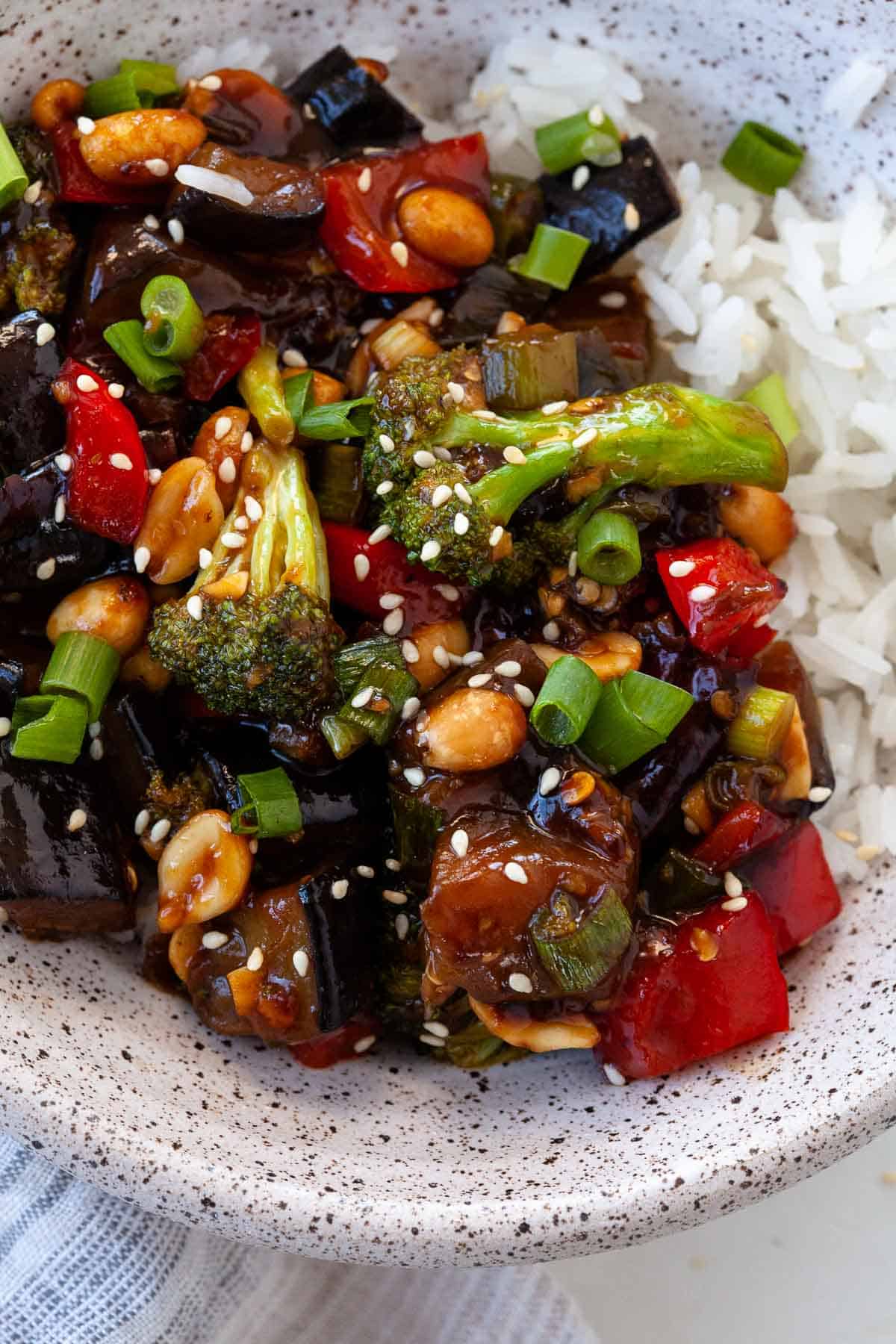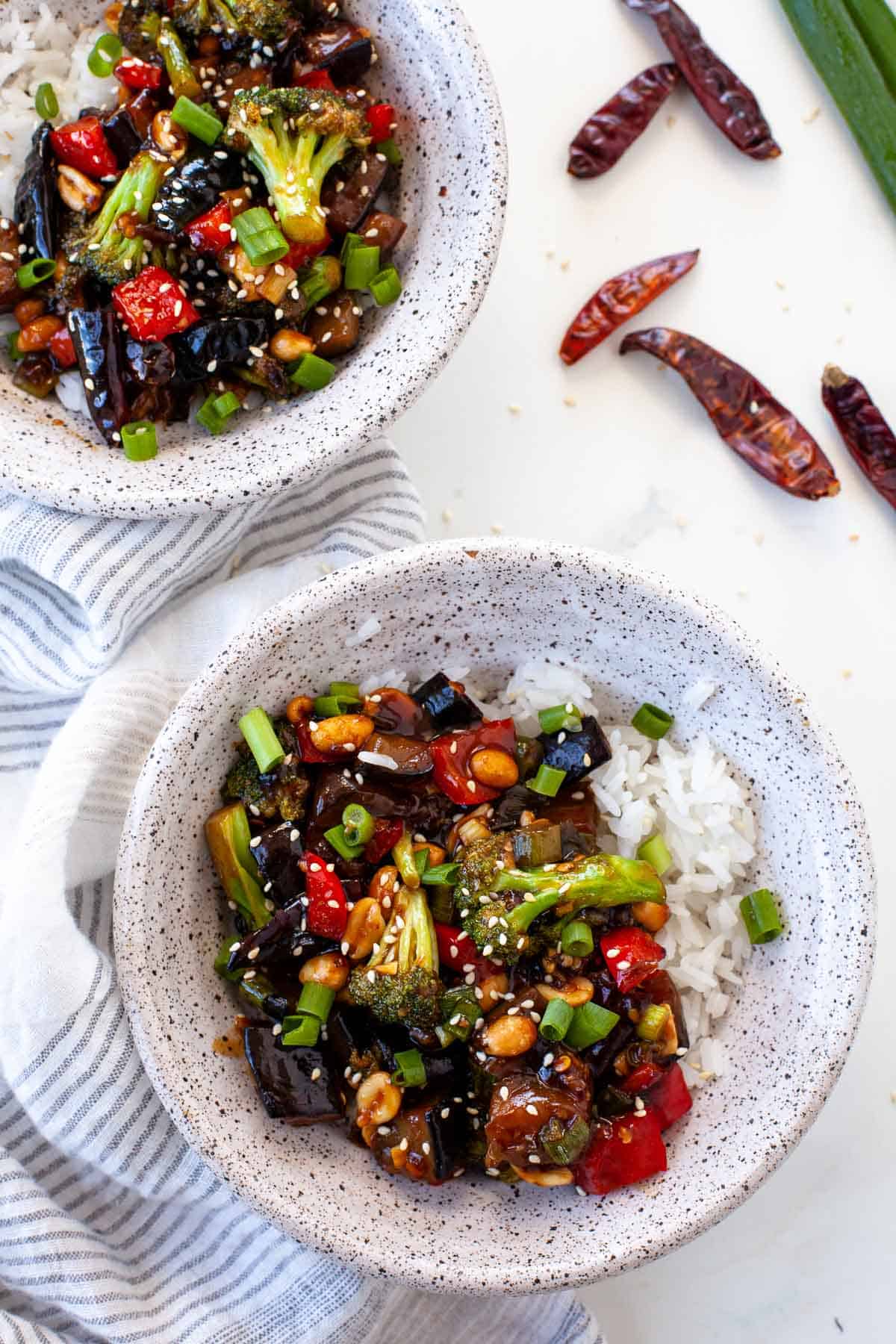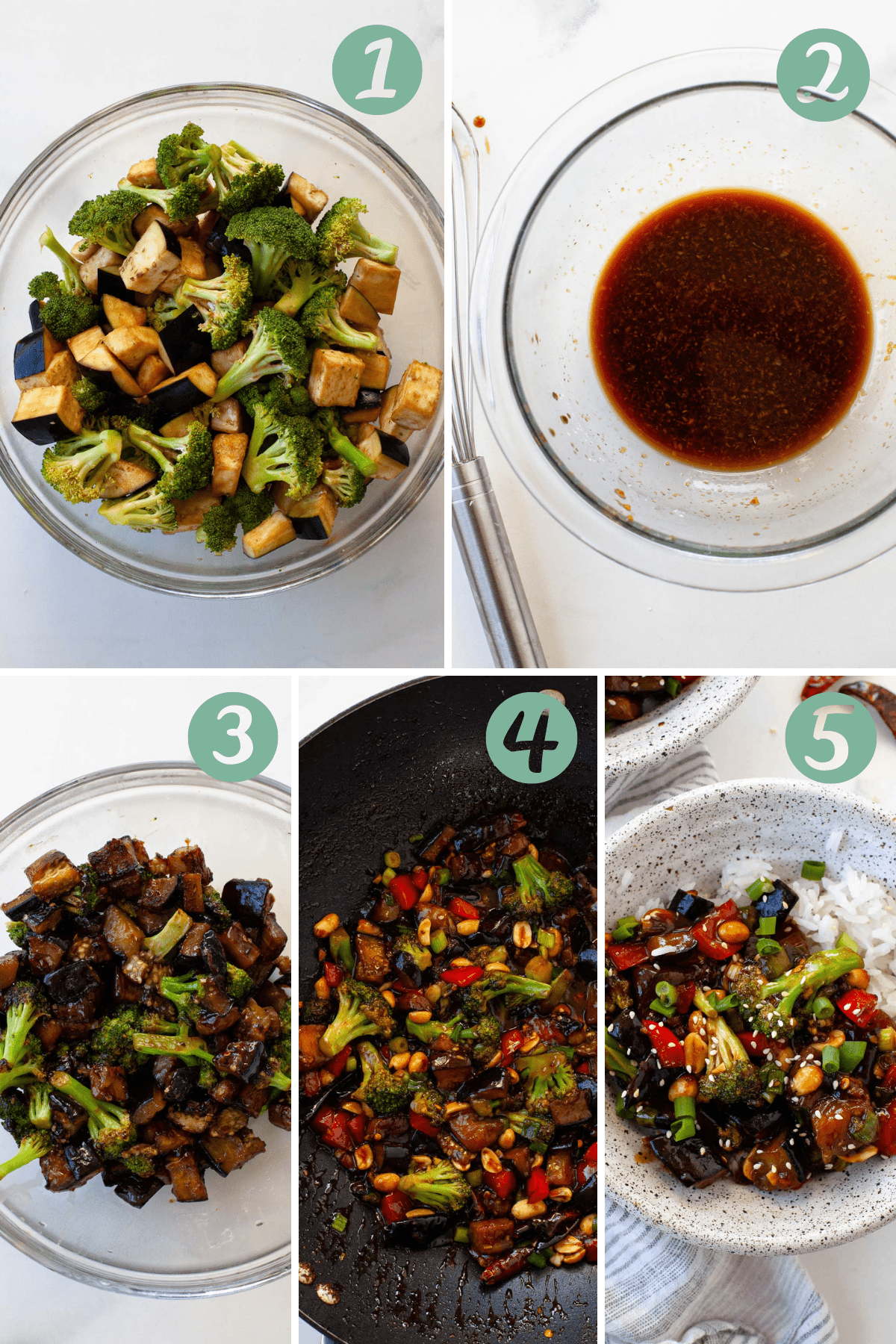


An easy weeknight dinner or side dish ready in less than 30 minutes, this kung pao vegetables recipe is made with eggplant, broccoli and bell pepper, coated in a sweet and savory sauce with a little spice.
There is nothing I love more than a savory and spicy sauté of all my favorite vegetables!
Inspired by kung pao chicken, which originated in the Sichuan Province of south-western China, this version boasts veggies like eggplant, broccoli and bell pepper, but you can use whichever veggies you have on hand! It’s easily customizable.
Make this a more complete and satiating meal by adding a source of protein! Think chicken, tofu, tempeh, shrimp or steak!
What really makes this recipe is the robust savory, sweet, and spicy sauce inspired by Asian flavors.
And the peanuts give the dish a satisfying crunch that complements the vegetables and adds a nice nutty flavor too.
The best part of this recipe is you need less than 30 minutes to make it!! Weeknight dinner rotation, here we come!
Ingredients You’ll Need

Notes on Ingredients:
- eggplant: tender, mild, and sweet with a slight bitterness. Can substitute with zucchini or squash!
- broccoli: I used fresh for this recipe but frozen can work too!
- sesame seed oil: gives a nutty, earthy flavor
- dried red chiles: cut the chiles into 1/2-inch pieces. If you can’t find these, substitute with 1/2 teaspoon red pepper flakes.
- red bell pepper: sweeter than the other bell peppers, but any color will work!
- dry-roasted peanuts: for a nutty crunch!
- scallions: give a oniony flavor and crunch to the dish
- mirin (rice wine): used to add sweet acidity to dishes.
- soy sauce: can sub for coconut aminos or use low-sodium if you want it less salty!
- corn starch: to thicken the sauce. Can substitute with flour or arrowroot starch if needed.
- black Chinese vinegar: if you can’t find this, substitute with 1 1/2 tablespoons balsamic vinegar + 1 1/2 tablespoons rice vinegar
Equipment You’ll Need (affiliate links – if you make a purchase I receive a small commission)
How to Make Kung Pao Vegetables

- Marinate the eggplant. Toss eggplant, broccoli and marinade ingredients (mirin, soy sauce and corn starch) together until fully coated. Set aside.
- Make the sauce. Add black vinegar, soy sauce, sugar, ginger, garlic, and corn starch to a small mixing bowl, and whisk to combine.
- Sauté vegetables. In a wok or large sauté pan, melt 2 tablespoons oil on high heat. Add eggplant and broccoli and cook until lightly golden brown and tender, about 6-8 minutes, deglazing the pan as needed. Transfer cooked vegetables back to the large mixing bowl and set aside.
- Add some spice. Add remaining 1 tablespoon oil to pan, add dried chiles and saute until fragrant, about 1-2 minutes. Add the bell pepper and cook until just tender, about 5-7 minutes.
- Toss with the sauce. Add the cooked eggplant and broccoli, peanuts, scallions, and the sauce and toss to coat. Cook until sauce is thickened, about 1 minute.
Expert Tips:
- Try chopping the vegetables as evenly as possible so they all cook evenly.
- To lessen the heat, remove seeds from chiles.
- Substitute vegetables for any that you desire or are in-season! Frozen can work as well! Defrost first and then drain out any remaining liquid before using.
- If the sauce is too thick, I recommend reconstituting with a little bit of water or extra soy sauce! If it’s too thin try adding more cornstarch.
Recipe FAQs
1. What exactly is kung pao?
The classic dish made with chicken in Sichuan cuisine originated in the Sichuan province of south-western China and includes Sichuan peppercorns. Kung pao sauce is sweet, savory, and spicy.
2. What if I don’t like eggplant?
That’s totally okay! You can substitute any of the vegetables for zucchini, squash, snap peas, mushrooms or any veggie you love!
3. Can I prep this in advance?
You can chop up the eggplant and broccoli in advance, and you can even whisk together the sauce ahead of time. But once you make the recipe I recommend serving it immediately as the vegetables can get mushy over time.

Substitutions and Additions
- If you don’t have red chiles on hand, you can substitute with 1/2 teaspoon red pepper flakes (less if you want it milder)
- Add shrimp, chicken, tofu, tempeh, or steak for a source of protein and to make this more filling!
- Other vegetables that would work well in this dish are mushrooms, snow peas, onion, baby corn, carrots, squash, zucchini, etc.
Storage and Preparation
Kung Pao Vegetables leftovers can be stored in an airtight container in the refrigerator for up to 3-4 days. I recommend reheating in a skillet on medium heat and tossing until warm.
Recipes That Pair Well

For more Asian-inspired recipe inspiration, check out my other recipes below!
If you like this recipe, please be sure to comment and give it a 5 star rating below. If you make it, share it on Instagram and tag me @karalydonrd and I’ll re-share it with my followers! If you want to save this recipe for later, be sure to pin it on Pinterest!
Description
An easy weeknight dinner ready in less than 30 minutes, this kung pao vegetables recipe is made with eggplant, broccoli and bell pepper, coated in a sweet and savory sauce with a little spice.
- 1 large eggplant, cut into 1-inch cubes
- 1 head of broccoli, cut into florets (about 3 1/2 cups)
- 3 tablespoons sesame seed oil, divided
- 9 dried red chiles, cut into 1/2-inch pieces
- 1 large red bell pepper, chopped (about 1 1/4 cups)
- 1/2 cup dry-roasted peanuts
- 3 scallions, thinly sliced, plus more for garnish
- Rice, for serving
For the marinade:
- 2 tablespoons mirin (rice wine)
- 2 tablespoons soy sauce
- 2 tablespoons corn starch
For the sauce:
- 3 tablespoons black Chinese vinegar (or 1 1/2 tablespoons balsamic vinegar + 1 1/2 tablespoons rice vinegar)
- 3 tablespoons soy sauce
- 2 tablespoons sugar
- 1 1/2 teaspoons fresh grated ginger
- 2 cloves garlic, minced or grated
- 1 1/2 teaspoons corn starch
- In a large mixing bowl, add eggplant, broccoli, and marinade ingredients (mirin, soy sauce and corn starch) and toss together until fully coated. Set aside.
- To make the sauce, add black vinegar, soy sauce, sugar, ginger, garlic, and corn starch to a small mixing bowl, and whisk to combine.
- In a wok or large saute pan, melt 2 tablespoons oil on high heat. Add eggplant and broccoli and cook until lightly golden brown and tender, about 6-8 minutes, deglazing the pan as needed. Transfer cooked vegetables back to the large mixing bowl and set aside.
- Turn down heat to medium-high. Add remaining 1 tablespoon oil to pan, add dried chiles and saute until fragrant, about 1-2 minutes. Add the bell pepper and cook until just tender, about 5-7 minutes.
- Add the cooked eggplant and broccoli, peanuts, scallions, and the sauce and toss to coat. Cook until sauce is thickened, about 1 minute.
- Serve immediately with rice and garnish with additional scallions.
Notes
- To add a source of protein, try adding chicken, tofu, tempeh, steak, or shrimp.
- This recipe is easily customizable to use whichever vegetables you have on hand or that you prefer: try mushrooms, snow peas, onion, baby corn, carrots, etc.
- For less spice, remove the seeds from the chiles.
- If you can’t find dried red chiles, use 1/2 teaspoon red pepper flakes (or less if you want a milder version).
- Prep Time: 8 minutes
- Cook Time: 14 minutes
- Category: Dinner
- Method: stir fry
- Cuisine: Chinese
Keywords: kung pao vegetables, vegan kung pao



